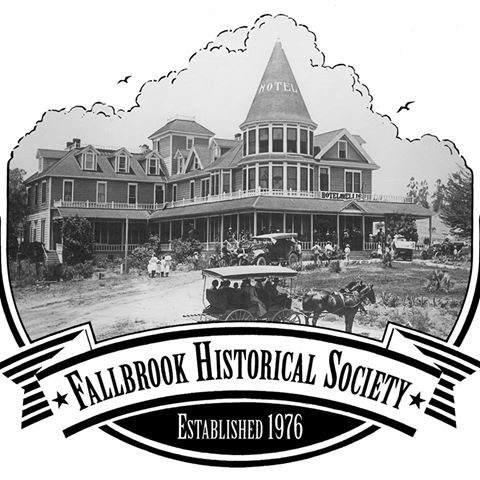The name Guajome (pronounced wah-ho’-may) comes from the Luiseño word “wakhavumi” which translated means frog pond. (1) A Luiseño Indian village associated with the Mission San Luis Rey with several ponds and a lake was located here during Spanish times.
After the Spanish left, Mexican California Governor Pio Pico, in1845 gave a land grant of 2,219 acres, the equivalent of one Spanish half-league, to Luiseño brothers Andrés and José Manuel, former neophytes at Mission San Luis Rey who had placed part of the land under cultivation and built a house. (2)
The two brothers sold the property soon thereafter for $550 to Abel Sterns, a wealthy Los Angeles businessman. Stearns, a native of Massachusetts, had arrived in California in 1829. Stearns was married to Arcadia Bandini, daughter of Don Juan Bandini, a prominent citizen of San Diego. (3)

Cave Couts was an American soldier, a West Point graduate, born near Springfield, Tennessee in 1821. (4) Couts had come to California with a company of soldiers in 1848 at the end of the Mexican American War to occupy San Diego. At the age of 28, Lieutenant Cave Couts was assigned to survey Old Town San Diego and is credited with preparing the city’s first official map, though the importance of this was much diminished when he subsequently misplaced the original map and could not produce it. (5)
On April 5, 1851, Couts married Ysidora Bandini, the other daughter of Juan Bandini, and a sister to Abel Stearns wife. As a wedding gift, Abel Stearns gave Cave Couts and his bride the title to Guajome Rancho. Couts resigned from the army to become a rancher, though he was soon appointed in 1852 by the American governor John Bigler as a colonel in the state militia. Colonel Couts designed a large ranch house in the traditional Spanish-California manner. The ranch house would eventually be made up of 22 rooms including children’s rooms, a school, the teacher’s room, a general store, an office, bedrooms, bathrooms, two kitchens, one bakery with a dining room, two pantries, guests rooms, servants rooms, tack room, a black smith shop, majordomo’s room, and plenty of patio and veranda areas. Additionally, Guajome Rancho had its own chapel and a resident priest.


Building materials were scarce. Initially, Couts scavenged some materials from the abandoned Mission San Luis Rey. Appointed as Indian agent, Couts had easy access to labor. Couts recruited 300 Indian workers. Adobe had to be dug from the ground and molded into many thousands of bricks. The construction took two years and was financed by selling beef with his growing cattle herds. Couts made his distinctive cattle brand of Cc.
Colonel Couts was a good business man, making the Rancho profitable. He also developed a reputation as a hard-drinking man with a murderous temper.
Couts was indicted twice in 1855 on charges of beating two Indians with a rawhide reata. In one charge of assault, Couts was acquitted. In the other case, the Indian named Halbini, died as a result. Couts was tried on a charge of manslaughter, but won dismissal on the grounds that one of the grand jurors was not an American citizen.
In 1863 Couts’ brother Blount Couts was infamously charged with killing Leon Vasquez, a mourner at the burial of their pious neighbor Ysidro Alvarado at the Sam Luis Rey Mission cemetery. Despite many witnesses, the charge was dropped for a paperwork discrepancy. In 1865, Couts was in old town San Diego, with his shotgun, when he saw Juan Mendoza, his former ranch foreman, whom he had a dispute with. There are different versions of exactly what was said, but agreement that Couts shot and killed Mendoza in the steet. Couts was indicted, but not convicted. (6) There was yet another 1865 charge that while evicting squatters Cave Couts and his brother Blount, had murdered four Indians and a Negro workman. Couts attorney had the indictment dismissed because the district attorney had not posted his bond of office. (7)
Cave Couts died In 1874 at the age of 53. Cave Jr. restored and lived at the old ranch house until 1948 when he died at the age of 87 and Cave III inherited. The land had remained in the family for 122 years, until 1973, when San Diego County purchased it for more than $1 million. Cave Jr.’s three elderly grandchildren–whose grandmother was Cave Jr.’s servant but never his wife–got the money. (8) Today Guajome is a County park.
Some people have maintained that Helen Hunt Jackson’s famous 1894 novel ‘Ramona’ was somewhat based on Guajome Rancho. (9)
- Rancho Guajome, an Architectural History preserved, Iris Engstrand and Mary Wand, San Diego History Center Fall 1995 quarterly.
- Rancho Guajome, a California Legacy preserved, Iris Engstrand and Thomas Scharf, San Diego History Center Winter 1974 quarterly.
- The Bancroft Library, Berkeley, California History of California, Vol. II, p. 770.
- Historic Ranchos of San Diego, Copley, 1969
- Lay of The Land, Michael J. Pallamary, the History of Land Surveying in San Diego County 2003 pg. 191-192
- Historic Ranchos of San Diego, Copley, 1969
- The Silver Dons, Richard Prourade, Chapter 14, San Diego History Center
- Los Angeles Times, Cecilia Rasmussen, Sept 22,2002
- ibid
